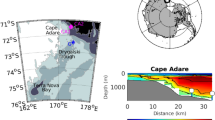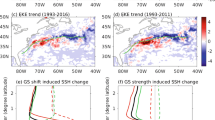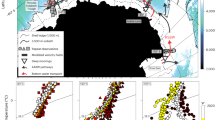Abstract
As it passes through the Florida Straits, the Gulf Stream consists of two main components: the western boundary flow of the wind-driven subtropical gyre and the northward-flowing surface and intermediate waters which are part of the ‘global conveyor belt’, compensating for the deep water that is exported from the North Atlantic Ocean1. The mean flow through the Straits is largely in geostrophic balance and is thus reflected in the contrast in seawater density across the Straits2. Here we use oxygen-isotope ratios of benthic foraminifera which lived along the ocean margins on the boundaries of the Florida Current during the Last Glacial Maximum to determine the density structure in the water and thereby reconstruct transport through the Straits using the geostrophic method—a technique which has been used successfully for estimating present-day flow3. Our data suggest that during the Last Glacial Maximum, the density contrast across the Florida Straits was reduced, with the geostrophic flow, referenced to the bottom of the channel, at only about two-thirds of the modern value. If the wind-driven western boundary flow was not lower during the Last Glacial Maximum than today, these results indicate a significantly weaker conveyor-belt component of the Gulf Stream compared to present-day values. Whereas previous studies based on tracers suggested that deep waters of North Atlantic origin were not widespread during glacial times, indicating either a relatively weak or a shallow overturning cell, our results provide evidence that the overturning cell was indeed weaker during glacial times.
This is a preview of subscription content, access via your institution
Access options
Subscribe to this journal
Receive 51 print issues and online access
$199.00 per year
only $3.90 per issue
Buy this article
- Purchase on Springer Link
- Instant access to full article PDF
Prices may be subject to local taxes which are calculated during checkout




Similar content being viewed by others
References
Schmitz,W. J. & McCartney,M. S. On the North Atlantic Circulation. Rev. Geophys. 31, 29–49 (1993).
Wust,G. Florida und Antillenstrom: Eine hydrodynamische Untersuchung. Geographischnaturwiss, Reihe 12, 48 (1924).
Lynch-Stieglitz,J., Currey,W. & Slowey,N. A geostrophic transport estimate for the Florida Current from oxygen isotope composition of benthic foraminifera. Paleoceanography 14, 360–373 (1999).
Larsen,J. C. Transport and heat-flux of the Florida Current at 27-degrees-N derived from cross-stream voltages and profiling data—Theory and observations. Phil. Trans. R. Soc. Lond. A 338, 169–236 (1992).
Kim,S. T. & O'Neil,J. R. Equilibrium and nonequilibrium oxygen isotope effects in synthetic carbonates. Geochim. Cosmochim. Acta 61, 3461–3475 (1997).
Craig,H. & Gordon,L. I. in Pro. 3rd Spoleto Conf., Spoleto, Italy (ed. Tongiori, E.) 9–130 (Sischi and Figli, Pisa, 1965).
Slowey,N. C. & Curry,W. B. Glacial-interglacial differences in circulation and carbon cycling within the upper western North-Atlantic. Paleoceanography 10, 715–732 (1995).
Haddad,G. A. & Droxler,A. W. Metastable CaCO3 dissolution at intermediate water depths of the Caribbean and western North Atlantic: Implications for intermediate water circulation during the past 200,000 years. Paleoceanography 11, 701–716 (1996).
Marchitto,T. M., Curry,W. B. & Oppo,D. W. Millennial-scale changes in North Atlantic circulation since the last glaciation. Nature 393, 557–561 (1998).
Kutzbach,J. et al. Climate and biome simulations for the past 21,000 years. Quat. Sci. Rev. 17, 473–506 (1998).
Seidov,D., Sarnthein,M., Strattegger,K., Prien,R. & Weinelt,M. North Atlantic ocean circulation during the last glacial maximum and subsequent meltwater event: A numerical model. J. Geophys. Res. 101, 16305–16332 (1996).
Boyle,E. A. & Keigwin,L. D. North Atlantic thermohaline circulation during the last 20,000 years linked to high latitude surface temperature. Nature 330, 35–40 (1987).
Duplessy,J.-C. et al. Deepwater source variation during the last climatic cycle and their impact on global deepwater circulation. Paleoceanography 3, 343–360 (1988).
Sarnthein,M. et al. Changes in east Atlantic deep-water circulation over the last 30,000 years—8 time slice reconstructions. Paleoceanography 9, 209–267 (1994).
Oppo,D. W. & Lehman,S. J. Mid-depth circulation of the subpolar North-Atlantic during the Last Glacial Maximum. Science 259, 1148–1152 (1993).
Fichefet,T., Hovine,S. & Duplessy,J.-C. A model study of the Atlantic thermohaline circulation during the last glacial maximum. Nature 372, 252–255 (1994).
Ganopolski,A., Rahmstorf,S., Petoukhov,V. & Claussen,M. Stimulation of modern and glacial climates with a coupled global model of intermediate complexity. Nature 391, 351–356 (1998).
Sigman,D. M. & Lehman,S. J. in American Geophysical Union Fall Meeting (AGU, San Francisco, California, 1995).
Yu,E. F., Francois,R. & Bacon,M. P. Similar rates of modern and last-glacial ocean thermohaline circulation inferred from radiochemical data. Nature 379, 689–694 (1996).
Lynch-Stieglitz,J., vanGeen,A. & Fairbanks,R. G. Interocean exchange of Glacial North Atlantic intermediate water: Evidence from Subantarctic Cd/Ca and carbon isotope measurements. Paleoceanography 11, 191–201 (1996).
Winguth,A. M. E., Archer,D., Duplessy,J.-C., Maier-Reimer,E. & Mikolajewicz,U. Sensitivity of paleonutrient tracer distributions and deep-sea circulation to glacial boundary conditions. Paleoceanography 14, 304–323 (1999).
McIntyre,A. et al. in Investigation of Late Quaternary Paleo-Oceanography and Paleoclimatology (eds Cline, R. M. & Hays, J. D.) 43–76 (The Geological Society of America, Boulder, 1976).
Labeyrie,L. D. et al. Changes in the vertical structure of the North-Atlantic Ocean between glacial and modern times. Quat. Sci. Rev. 11, 401–413 (1992).
Curry,W. B. in The South Atlantic: Present and Past Circulation (eds Wefer, G., Berger, W. H., Siedler, G. & Webb, D.) (Springer, New York, 1996).
Slowey,N. C. & Curry,W. B. Enhanced ventilation of the North Atlantic subtropical gyre thermocline during the last glaciation. Nature 358, 665–668 (1992).
Fairbanks,R. G. A 17,000-year glacio-eustatic sea-level record—Influence of glacial melting rates on the Younger Dryas Event and deep-ocean circulation. Nature 342, 637–642 (1989).
Schrag,D. P., Hampt,G. & Murray,D. W. Pore fluid constraints on the temperature and oxygen isotopic composition of the glacial ocean. Science 272, 1930–1932 (1996).
Joussaume,S. & Jouzel,J. Paleoclimatic tracers—An investigation using an atmospheric general-circulation model under ice-age conditions. 2. Water isotopes. J. Geophys. Res. Atmos. 98, 2807–2830 (1993).
Levitus,S. & Boyer,T. P. World Ocean Atlas 1994 (National Oceanic and Atmospheric Administration, Washington DC, 1994).
Leaman,K. D., Johns,E. & Rossby,T. The average distribution of volume transport and potential vorticity with temperature at 3 sections across the Gulf-Stream. J. Phys. Oceanogr. 19, 36–51 (1989).
Slowey,N. C. et al. Glacial to Holocene sedimentation on the western slope of Great Bahama Bank. Geo-Mar. Lett. (submitted).
Acknowledgements
This work was supported by grants from the US National Science Foundation and a grant/cooperative agreement from the National Oceanic and Atmospheric Administration. The views expressed herein are those of the authors and do not necessarily reflect the views of NOAA or any of its subagencies. Support for the curating facilities of the Lamont-Doherty Earth Observatory Deep-Sea Sample Repository is provided by the National Science Foundation and the Office of Naval Research. We are grateful to J. Mayer, A. LeGrande, D. Ostermann and M. Yeager for technical assistance.
Author information
Authors and Affiliations
Corresponding author
Rights and permissions
About this article
Cite this article
Lynch-Stieglitz, J., Curry, W. & Slowey, N. Weaker Gulf Stream in the Florida Straits during the Last Glacial Maximum. Nature 402, 644–648 (1999). https://doi.org/10.1038/45204
Received:
Accepted:
Issue Date:
DOI: https://doi.org/10.1038/45204
This article is cited by
-
Living on the edge: environmental variability of a shallow late Holocene cold-water coral mound
Coral Reefs (2022)
-
Evidence for influx of Atlantic water masses to the Labrador Sea during the Last Glacial Maximum
Scientific Reports (2021)
-
Influence of surface ocean density on planktonic foraminifera calcification
Scientific Reports (2019)
-
Deep mitochondrial lineage divergence among populations of the southern stingray (Hypanus americanus (Hildebrand & Schroeder, 1928)) throughout the Southeastern United States and Caribbean
Marine Biodiversity (2019)
-
A genomic assessment of movement and gene flow around the South Florida vicariance zone in the migratory coastal blacknose shark, Carcharhinus acronotus
Marine Biology (2019)
Comments
By submitting a comment you agree to abide by our Terms and Community Guidelines. If you find something abusive or that does not comply with our terms or guidelines please flag it as inappropriate.



